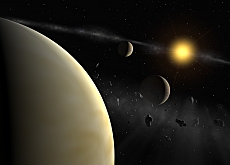Galaxies cannibalise smaller brethren

Scientists at Zurich University and the Federal Institute of Technology claim to have discovered the origins of some of the universe's darkest galaxies.
Computer simulations show that massive host galaxies literally suck visible matter out of their tinier brethren orbiting around them.
Dark galaxies are among the darkest objects found in the Universe and are quite widespread, according to astrophysicists. Lucio Mayer, lead scientist on the Zurich project, says that they can be detected thanks to the few stars they still contain.
“New technology and telescopes allows us to discover fainter stars and galaxies than ever before,” he told swissinfo in his office above Zurich.
But how did they become almost invisible? Using super-computer simulations, the research team believes it was a three-step process that began ten billion years ago.
First, the gas within the satellite galaxy was warmed by cosmic ultraviolet radiation. As the dwarf moved on an orbit around a massive host galaxy, so-called ram pressure – a sort of wind resistance – removed the heated gas.
At the same time Mayer explains, the huge gravitational forces of the host ripped stars from its satellite. Finally, as the dwarf galaxy continued on its to orbit, it was struck by a phenomenon known as tidal shocking, losing even more of its stars.
All that is left is so-called dark matter that is hardly affected by the titanic forces at play. This leaves the satellite galaxy a shadow of its former self, with its visual signature ripped out.
Previously, scientists thought that dark galaxies were like that from the start.
Losing matter
Mayer describes the process unfolding on his computer screen as being not unlike a comet losing matter as it passes around the Sun. Simulations show a small galaxy’s tail being drawn towards the larger host rather than heading away from it though.
The results go some way towards explaining the distorted shapes of some galaxies. Mayer reckons they could also help solve the mystery of why so few small galaxies have been found around our Milky Way and the Andromeda Nebula.
In theory, there should be five to ten times more than the ten to 20 small galaxies discovered so far.
But the results can also seem somewhat perplexing. Although astrophysicists like Mayer think that dark matter is what remains in the dwarves, no one actually knows what constitutes it.
It cannot be detected directly, but its presence can only be inferred by the gravitational forces it produces on visible matter. According to measurements carried out in the 1970s and 1980s, it could account for 90 per cent of the mass in the known universe.
“What it is exactly, we don’t know,” admits Mayer. “We know it’s mass, but we have no idea what particles this dark matter is made of, so studying dark galaxies is a way of finding this out.”
Computer power
Tracking changes in the structure of galaxies over billions of years might seem a little irrelevant to the man or woman on the street, but this type of research does have a silver lining.
For their simulations, the scientists use what many specialists consider the most advanced type of information technology; parallel computing. These systems work faster by splitting up tasks and carry them out simultaneously.
In Zurich, two computers of this type were put to work, and according to Mayer, the research puts the people who programmed the systems at the top of their field.
swissinfo, Scott Capper in Zurich
A dark galaxy is a galaxy-sized object containing very few or no stars.
It may contain gas, dust and dark matter.
Several objects have been suggested to be dark galaxies, but some claims have later been disproved.
A dwarf galaxy is a small galaxy composed of up to several billion stars, a small number compared to our own Milky Way’s 200-400 billion stars.
The Large Magellanic Cloud, containing over 30 billion stars, is sometimes classified as a dwarf galaxy while others consider it a full-fledged galaxy going around the Milky Way.
The Big Bang Theory is the dominant scientific theory about the origin of the Universe.
The term is used to refer to a point in time when the observed expansion of the universe began — estimated to be around 13.7 billion years ago.
According to the theory, the universe was created from a cosmic explosion that hurled matter in all directions.
In 1927, the Belgian priest Georges Lemaître was the first to suggest that the universe began with the explosion of a primeval atom.
Years later, American Edwin Hubble was able to justify Lemaître’s theory, showing that distant galaxies are moving away from us in every direction at speeds proportional to their distance.

In compliance with the JTI standards
More: SWI swissinfo.ch certified by the Journalism Trust Initiative










You can find an overview of ongoing debates with our journalists here . Please join us!
If you want to start a conversation about a topic raised in this article or want to report factual errors, email us at english@swissinfo.ch.